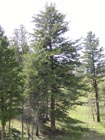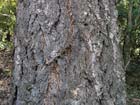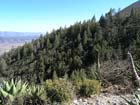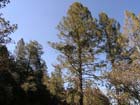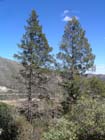Conservation Status

Pseudotsuga menziesii subsp. glauca
(Beissn.) E. Murray 1982
Common names
Interior Douglas-fir, Rocky Mountain Douglas-fir, blue Douglas-fir; guayamé, hayarín, pinabete [Spanish].
Taxonomic notes
Synonymy:
Tsuga lindleyana Roezl 1857;
Pseudotsuga lindleyana (Roezl) Carr. 1868;
Tsuga douglasii (Sabine ex D. Don) Lindl. var. glauca Beissn. 1884;
Pseudotsuga douglasii (Lindley) Carr. var. glauca Mayr 1890;
Pseudotsuga flauhaultii Flous 1934;
Pseudotsuga guinieri Flous 1934;
Pseudotsuga macrolepis Flous 1934;
Pseudotsuga menziesii (Mirb.) Franco var. glauca (Beissn.) Franco 1950;
Pseudotsuga menziesii (Mirb.) Franco var. flauhaultii Silba 1990;
Pseudtosuga menziesii var. oaxacana Debreczy et Rácz 1995.
The proliferation of synonyms for this subspecies is at least partly due to the question of whether any of the Mexican populations warrant treatment as distinct taxa. The species occupies a huge latitudinal range, from British Columbia to Oaxaca, and southern trees have sparser foliage with fewer abaxial stomata; the cones are very similar, but usually lack the reflexed bracts; and I have found them to have a somewhat larger length:width ratio. These differences are ecotypical and reflect the southern populations' adaptation to a warmer and more arid climate. See Pseudotsuga menziesii for a description of the chemical and genetic evidence for infraspecific variation in the species.
Description
Trees to 50 m tall and 125 cm dbh. Bark smooth grey on young trees, becoming shallowly fissured, purplish-grey with yellowish-buff fissures. The bark of mature trees is often rough and black compared to the typically brown, often flaky bark on the coastal variety. Crown dense to sparse (generally more open in more southern populations), with level branches and slightly drooping twigs. Trees often carry substantial loads of epiphytic lichens including Bryoria sp., Usnea sp. and Letharia sp. Leaves vary widely in color, usually dark green to grey-green, sometimes glaucous, commonly pointing forward along the shoot and slightly outcurved at the tips (particularly on sun foliage; spreading more widely on shade foliage), 1-3 cm long, 1-1.2 mm wide, with two adaxial gray stomatal bands. Cones purple with green bracts, ripening buff-brown, 3-7 cm long, ovoid to ovoid-cylindric; scales 2-2.5 cm broad; bracts exserted 1-2 cm, moderately straight to spreading or reflexed. 2n=26 (Johnston 1943, Martínez 1953, Frankis 1991, Lipscomb 1993, Debreczy and Rácz 1995, Arevalo and Elizondo 1998).
Distribution and Ecology
Canada: Alberta and British Columbia; USA: Montana, Idaho, Washington, Oregon, Nevada, Utah, Wyoming, Colorado, Arizona, New Mexico and Texas; Mexico: Sierra Madre Occidental, Sierra Madre Oriental, and rare in the Sierra Madre del Sur, south to Oaxaca, where two small populations occur on Peña Prieta in the San Felipe Mts just north of Oaxaca City, and on Cerro Quiexobra 110 km SE of Oaxaca City, this at 16°22'N, the southernmost locality for the whole genus (Debreczy and Rácz 1995). Found at 600-3300 m (elevation generally inverse with latitude) in conifer or mixed forests (Lipscomb 1993).
Forests often have Pseudotsuga regeneration beneath a Pseudotsuga canopy, a situation very rarely encountered in the coastal subspecies. The regeneration may grow extremely slowly; I have an example of a basal disc 3 cm diameter, containing 100 annual rings. The tree was about 2 m tall.
The species is not of conservation concern in Canada and the U.S. All populations in central and southern Mexico, however, are threatened by human encroachment and climate warming. The small stands in Queretaro, Hidalgo, Veracruz, and Tlaxcala have all been heavily impacted by wood cutting, grazing, and fire. The regeneration of Douglas-fir at these sites is also very poor, and the species may disappear entirely from these locations in central Mexico in the foreseeable future. The stands in Puebla and Oaxaca are in better condition (Stahle et al. 2003).
Compared to subsp. menziesii, forests of subsp. glauca occur in more diverse soil parent materials, climates and topography, and are more frequently subject to insect attack and fire. Parent materials are commonly of silicate or carbonate origin, and usually have relatively low organic content due to aridity and/or fire.
The following discussion addresses the Canadian and American populations:
"The range of [interior] Douglas-fir is fairly continuous through northern Idaho, western Montana, and northwestern Wyoming. Several outliers are present in Alberta and the eastern-central parts of Montana and Wyoming, the largest being in the Bighorn Mountains of Wyoming. In northeastern Oregon, and from southern Idaho south through the mountains of Utah, Nevada, Colorado, New Mexico, Arizona, extreme western Texas, and northern Mexico, the distribution becomes discontinuous.
"Douglas-fir grows under a wide variety of climatic conditions [see Table, below] ... In the northern Rocky Mountains, Douglas-fir grows in a climate with a marked maritime influence. Mild continental climate prevails in all seasons, except midsummer. Precipitation is evenly distributed throughout the year, except for a dry period in July and August. In the central Rocky Mountains, the climate is continental. Winters are long and severe; summers are hot and in some parts of the region, very dry. Annual precipitation, higher on the western sides of the mountains, is mainly snow. Rainfall patterns for the southern Rocky Mountains generally show low winter precipitation east of the Continental Divide but high precipitation during the growing season. West of the Continental Divide, the rainfall is more evenly divided between winter and summer. Frost may occur in any month in the northern part of the range. Length of frost-free periods, however, varies within the central and southern Rocky Mountain regions, even at the same elevations.
"Soils within the range of Rocky Mountain Douglas-fir originated from a considerable array of parent materials. In south-central British Columbia, eastern Washington, and northern Idaho, soils vary from basaltic talus to deep bess with volcanic ash to thin residual soil over granitic or sedimentary rocks. They are mostly Vitrandepts and Xerochrepts. Parent materials in Montana and Wyoming consist of both igneous and sedimentary rocks, and locally of glacial moraines. Soils derived from noncalcareous substrates are variable in texture but consistently gravelly and acidic. A significant portion of the sedimentary rocks is limestone, which gives rise to neutral or alkaline soils ranging in texture from gravelly loams to gravelly silts. Limestones often weather into soils that are excessively well drained. Soils are Cryoboralfs of the order Alfisols, and Cryandepts and Cryochrepts of the order Inceptisols. Soils in the central and southern Rocky Mountains are very complex. They developed from glacial deposits, crystalline granitic rocks, conglomerates, sandstones, and, in the Southwest, limestones. These soils are Alfisols (Gray Wooded soils), Mollisols (Brown Forest soils), Spodosols (Brown Podzolic soils, Podzols), and Entisols.
"Generally, the variety glauca grows at considerably higher altitudes than the coastal variety of comparable latitude. ... The inland variety grows at elevations from 550 to 2440 m (1,800 to 8,000 ft) in the northern part of its range. In the central Rocky Mountains, Douglas-fir grows mostly at elevations between 1830 and 2590 m (6,000 and 8,000 ft), and in the southern Rocky Mountains, between 2440 and 2900 m (8,000 and 9,500 ft). In some localities in southern and central Arizona, Douglas-fir may be found as low as 1550 m (5,100 ft) in canyon bottoms. The highest elevation at which Douglas-fir grows in the Rocky Mountains is 3260 m (10,700 ft) on the crest of Mount Graham in southeastern Arizona.
"Rocky Mountain Douglas-fir grows in extensive pure stands, uneven- and even-aged, in southern Idaho and northern Utah and in western Montana as a broad belt between ponderosa pine and spruce fir zones. At high elevations or northerly latitudes, more cold-tolerant mountain hemlock (Tsuga mertensiana), whitebark pine (Pinus albicaulis), true firs (Abies spp.), Engelmann spruce (Picea engelmannii), western white pine (Pinus monticola), and lodgepole pine (Pinus contorta) gradually replace Douglas-fir. ...
"Wherever Douglas-fir grows in mixture with other species, the proportion may vary greatly, depending on aspect, elevation, kind of soil, and the past history of an area, especially as it relates to fire. This is particularly true of the mixed conifer stands in the southern Rocky Mountains where Douglas-fir is associated with ponderosa pine, southwestern white pine (Pinus strobiformis), corkbark fir (Abies lasiocarpa var. arizonica), white fir (Abies concolor), blue spruce (Picea pungens), Engelmann spruce, and aspen (Populus spp.).
"Principal understory species associated with variety glauca differ within its range. In the northern part, they are common snowberry (Symphoricarpos albus), white spirea (Spirea betulifolia), ninebark (Physocarpus malvaceus), and pachistima (Pachistima myrsinites). In the central part, they are true mountain-mahogany (Cercocarpus montanus), squaw currant (Ribes cereum), chokeberry (Prunus virginiana), big sagebrush (Artemisia tridentata), western serviceberry (Amelanchier alnifolia), and bush rockspirea (Holodiscus dumosus); in the southern part they are New Mexico locust (Robinia neomexicana), Rocky Mountain maple (Acer glabrum), and oceanspray" (Burns & Honkala 1990).
Table 1. Climatic data for [three] regional subdivisions of the range of [Rocky Mountain] Douglas-fir (Source: Burns & Honkala 1990).
| Region | Mean temperature | Frost-free
period | Mean precipitation |
| July | January | Annual | Snow fall |
| °C | °C | days | mm | cm |
| Rocky Mountains: Northern | 14 to 20 | -7 to 3 | 60 to 120 | 560 to 1020 | 40 to 580 |
| Rocky Mountains: Central | 14 to 21 | -9 to -6 | 65 to 130 | 360 to 610 | 50 to 460 |
| Rocky Mountains: Southern | 7 to 11 | 0 to 2 | 50 to 110 | 410 to 760 | 180 to 300 |
Remarkable Specimens
The tallest, and largest in the state of Idaho, is a tree near Clarkia 67.4 m tall and 179 cm dbh. The largest specimen known in Washington is 53.3 m tall and 191 cm dbh, and grows in the Umatilla National Forest. In British Columbia, the largest known trees are 45.7 m tall and 185 cm dbh for a tree near Princeton, and 37.5 m tall and 194 cm dbh for a tree near Bridesville (Robert Van Pelt e-mail 2004.02.04). In Mexico it is rarely a large tree, with 40 m height and 125 cm dbh the maximum I have seen cited anwhere, for (a) tree(s) near San Dimas, Durango (Martínez 1953).
The oldest record is a crossdated age of 1275 years for specimen BIC 63 from northern New Mexico, collected by Henri Grissino-Mayer (Brown 1996). I believe this is from a living tree, collected in the late 1980s or early 1990s.
Ethnobotany
During initial Euroamerican settlement within the species' range, it was widely exploited for its strong, workable timber; due to its strength, it was particularly preferred for structural uses such as mine timbers and railroad trestles. It continues to be widely exploited in the western U.S. and Canada as a commercial timber species. It may be equally or more valuable for the contribution it makes to ecosystem services in the region, providing watershed, cover for cattle and wildlife, large woody debris and standing snags that provide habitat for a huge array of organisms, and (through its prolific production of seed cones) forage for many birds and small mammals.
This is an important species for dendrochronology. Early work by Schulman (1941) established the suitability of the species for analysis and began the collection of numerous chronologies from the American Southwest. Brubaker and Graumlich collected several chronologies from Washington in the 1980s, and since then, the species has been often used in climate and ecological studies.
Observations
Some fine stands are in the Okanogan area of Washington, for instance along the road from Winthrop to Mount Tiffany and along the trails into the southern Pasayten Wilderness. It is also common in the Rockies (from Idaho and Montana south to Arizona). Large trees are fairly common; for instance, I once found a specimen 170 cm in diameter in a riparian area of the Chiricahua Mtns. of SE Arizona, and stands with many trees over 100 cm dbh occur atop the Santa Catalina Mtns. in Arizona.
In Mexico, it may be seen scattered among pines and Abies vejari on the NE slopes of Cerro Potosí at up to 3000 m (Debreczy and Rácz 1995), and is frequent (but rarely dominant) on other moist high altitude sites throughout Northern Mexico.
Remarks
The subspecies epithet glauca recognizes a tendency towards glaucous foliage.
Mexican Douglas-fir has a rather thin, sparse crown with 'dried-up' looking foliage, due to the leaves hugging the shoots closely and making the leaved shoot slender (Frankis 1991), a distinct character maintained in cultivated trees in Britain (Frankis pers. obs.). The immature cones, purple with yellow-green bracts, are very attractive and can be produced very freely on young trees only 2-3 m tall in cultivation in Britain (Frankis pers. obs.); these are the best reason for growing it as an ornamental given the fairly drab foliage.
Some Mexican populations have foliage similar to some of the Abies taxa found in the same area, an interesting example of convergent evolution. Of Abies durangensis var. coahuilensis, Johnston (1943) wrote: "The Coahuilan tree grows intermixed with Pseudotsuga and simulates that tree to a truly remarkable degree. The two have not been distinguished by local people knowing the forests, and I must confess that I should not have been aware that an Abies was growing with Pseudotsuga in the Sierra Madre had I not chanced upon Abies cones cut down by squirrels". A similar convergence of foliage character exists with Abies vejari (Frankis 1991).
Citations
Arevalo, A. Garcia and M. Socorro González Elizondo. 1998. Pinaceas de Durango. Durango.
Debreczy, Z. and I. Rácz. 1995. New species and varieties of conifers from Mexico. Phytologia 78: 217-243. Available: Biodiversity Heritage Library, accessed 2021.12.19.
Flous, F. 1934a. Deux espèces nouvelles de Pseudotsuga Américains. Bull. Soc. Hist. Nat. Toulouse 66: 211-224.
Flous, F. 1934b. Diagnoses d'espèces et variétés nouvelles de Pseudotsuga Américains. Bull. Soc. Hist. Nat. Toulouse 66: 329-346.
Frankis, M. P., Nov-1991 field notes and herbarium collections, NE Mexico.
Frankis, M. P., pers. obs., of trees cultivated as 'Ps. macrolepis Flous' at Bedgebury Pinetum (Kent), Bicton Park (Devon) and Wakehurst Place (Sussex), planted c. 1970 from seed from an unknown locality in Mexico.
Johnston, I. M. 1943. Plants of Coahuila, eastern Chihuahua, and adjoining Zacatecas and Durango. Journal of the Arnold Arboretum 24:306-339. Available: Biodiversity Heritage Library, accessed 2021.12.19.
Martínez, M. 1953. Las Pinaceas Méxicanas. México City.
Schulman, E. 1941. Douglas fir chronology in Santa Catalina Mountains, Arizona. Tree-Ring Bulletin 7(3):18-19.
Stahle, David W., Matthew D. Therrell, Jose Villanueva Diaz, and Eladio Cornejo Olviedo. 2003. The Ancient Douglas-fir (Pseudotsuga menziesii) Forest near Cuauhtemoc la Fragua, Puebla, Mexico. www.uark.edu/misc/dendro/cuauhtemoc.pdf, accessed 2015.01.23, now defunct.
See also
MacKinnon et al. (1992).
FEIS database.
